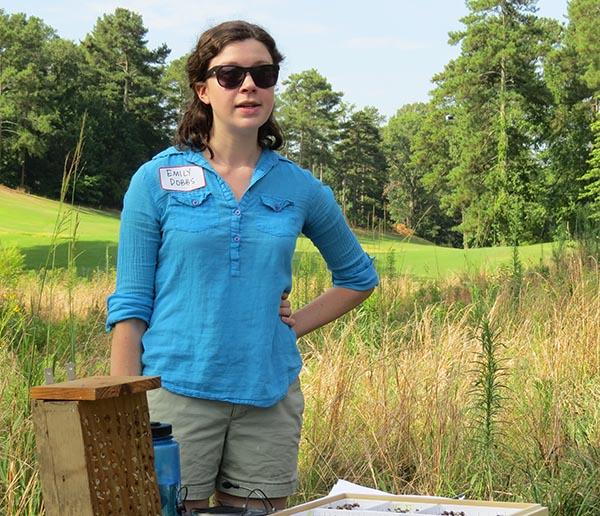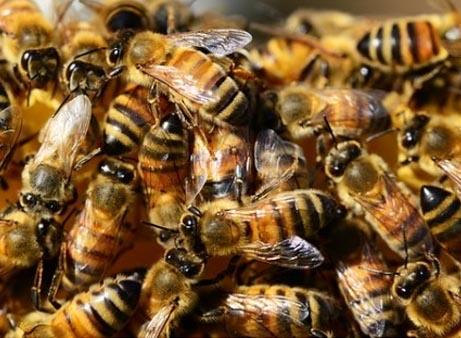Sometimes talking a good game just is not enough.
 There are some initiatives that take place in golf that sound good, but the results are difficult to quantify. But it's hard not to recognize the benefits of providing a habitat for pollinating insects.
There are some initiatives that take place in golf that sound good, but the results are difficult to quantify. But it's hard not to recognize the benefits of providing a habitat for pollinating insects."They need our help because their numbers are declining," said Matt Ceplo, CGCS at Rockland Country Club in Sparkill, New York. "(They) pollinate food crops, (are an) environmental indicator - canary in coal mine kind of thing, (they are) good PR and a food source for many birds and larger predators. It's fun and interesting."
The bee population, according to the U.S. Department of Agriculture, dropped steadily from 1989 to 2008, but has been on the rise ever since. There were 2.66 million commercial bee colonies in 2015, which is just slightly less than the 2.7 million in 2014 that represented a 20-year high, according to the USDA.
Ceplo has spent the better part of two decades, 19 years to be exact, providing habitat for butterflies, birds, caterpillars (moths) and now pollinating insects. The course is home to wood-boring and ground-nesting bees, and he helps them along by providing nesting habitat in the way of wood blocks and sandy ground.
His ongoing work was the subject of a recent case study by the New York State Turfgrass Association.
About 10 percent of Rockland's 140 acres are dedicated to natural or non-managed areas.
 The first step in the process, says Ceplo, is identifying desirable insects to attract and the right plant life that will accomplish that goal. Native plants seem to make the most sense because they require the least amount of care, but all native plants are not created equally.
The first step in the process, says Ceplo, is identifying desirable insects to attract and the right plant life that will accomplish that goal. Native plants seem to make the most sense because they require the least amount of care, but all native plants are not created equally.In some plants, like forsythia, Ceplo said, it is difficult for insects to get to the pollen, so they ignore it. There are others, like purple loosestrife which is not native to New York, that are like catnip to pollinators.
"The subject is far from black and white," Ceplo said. "There is a world of gray."
What is certain, said Fred Gehrisch, CGCS at Highlands Falls Country Club in Highlands, North Carolina, are the benefits of attracting pollinators.
"We're doing it to protect the environment," Gehrisch said.
"You can talk about doing the right thing, but sometimes you just have to step up and do the right thing."
Gehrisch has maintained several acres of low-maintenance native areas for years. Last year he started two bee hives on the property and added three more this year.
Emily Dobbs is the manager of the Brosi Lab at Emory University in Atlanta. She also helped plant and manage the first Operation Pollinator plot in the United States when she was a graduate student for Dan Potter, Ph.D., at the University of Kentucky.
She says there are many advantages to using native plants to attract beneficial insects.
 "I would suggest using as many native wildflower species as possible, because they generally support a more diverse group of our native bees, both nutritionally and in terms of nesting habitat, and are often lower maintenance than non-natives," Dobbs said via email.
"I would suggest using as many native wildflower species as possible, because they generally support a more diverse group of our native bees, both nutritionally and in terms of nesting habitat, and are often lower maintenance than non-natives," Dobbs said via email. Golf courses make great pollinator habitats, she said, because superintendents who manage them have horticultural expertise, and the properties are protected from large numbers of people. Also, so many golf courses in urban and suburban areas often provide the only large swaths of habitable landscape for some insects. Bees can travel for two to three miles from their hive in search of pollen.
Dobbs suggests checking with local extension agents to help identify plants that are both hearty and will support pollinators.
"Having all native plant species is also useful if you are trying to get certification with the Audubon Society, etc. That doesn't mean that non-native wildflower species are terrible for bees," she said. "For example, many members of the mint, aster, and rose families are excellent perennials for bee plantings, most of which are not native to eastern North America."
Raising bees on the golf course also can be good public relations for an industry that needs it, and is a positive way to further engage members on the good works of their greens staff.
"I can't tell you how much goodwill it has established with members. They love them," Gehrisch said. "They're always asking 'how are they doing?' "
That acceptance, at least from some members, didn't all come automatically. Bees are non-aggressive, almost aloof insects - as long as you don't antagonize them.
"It took a little education," Gehrisch said. "A few people were worried about being stung and swarming bees. Before I could say anything, other members told them that the bees were already here, and that we were not just harvesting them. They see me go to the apiary with no protective clothes on and then realize they are not aggressive at all."

